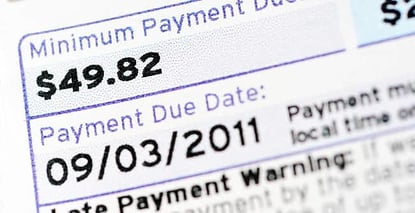One of the first things you should consider when exploring new credit cards are their methods for calculating minimum payments because there are multiple techniques the credit card companies use.
The minimum payment is the amount you must fork over each month based upon your unpaid balance, interest and fees. The Credit CARD Act of 2009 created new rules regarding how issuers must report information about minimum payments.
Percentage Methods
Typically, credit card companies charge a percentage of the unpaid balance as the minimum payment. You’ll want to look in the card’s terms and conditions for this figure. For example, if you owe $1000 on a card with a 2.5 percent figure, that means you have to cough up a $25 minimum payment for the month.
Some of that payment will apply toward interest, and the rest will go to reducing your debt (in a very meager way). If you miss a payment, your issuer might raise your percentage and/or charge you a fee. The first late fee in a six-month period is capped at $25 by the CARD Act.
Interest Methods
Some credit card companies may figure your minimum payment only on the interest you owe. The interest rate is advertised up front as the card’s APR, or annual percentage rate.
Figure about 1/12 of that rate is your monthly interest charge. If you have a 12 percent APR and a $1,000 balance, you might only have to pay 1/12 of 12 percent, or 1 percent, equal to $10.
Note that this doesn’t pay down any of your principal, making the debt very expensive in the long run. Some cards tack on an additional amount, say another 1 percent, to ensure you are paying at least a little to reduce your balance.
If your card charges different interest rates on different activities (purchases, balance transfers, cash advances), the CARD Act requires that any money paid above the minimum must be applied to the highest-interest items first.
Fixed Minimums
Almost every issuer has an absolute minimum monthly payment amount. If your balance exceeds this amount, you will have to pay the absolute minimum, even if it’s more than what you’d owe under the methods already discussed.
The fixed minimum must be disclosed in the credit card’s terms and conditions, which you should read and understand before signing up for the card.
Effects of the CARD Act
The Credit CARD Act of 2009 made sweeping changes to the ways credit card issuers can behave and the information they must provide.

President Obama signing the Credit CARD Act of 2009 into law on May 22, 2009.
Regarding minimum payments, the Act requires:
- Issuers must disclose how long it will take you to pay off your balance if you make only minimum payments. You might find the answer shocking: measured in decades rather than years.
- Issuers must disclose how much you’d have to pay each month to eliminate your balance in three years, including the interest costs.
Set Your Own Minimum
If you can only pay the minimum each month, then you are overextended and need to cut your spending, consolidate your debt or take other steps so you can pay more than the monthly minimum.
Set a target date to clear your current balance and make monthly payments accordingly. Otherwise, you might end up paying double or triple the prices of purchases because of interest and fees.
Image credits: credittipstoday.com, ausubel.com
Advertiser Disclosure
CardRates.com is a free online resource that offers valuable content and comparison services to users. To keep this resource 100% free, we receive compensation for referrals for many of the offers listed on the site. Along with key review factors, this compensation may impact how and where products appear across CardRates.com (including, for example, the order in which they appear). CardRates.com does not include the entire universe of available offers. Editorial opinions expressed on the site are strictly our own and are not provided, endorsed, or approved by advertisers.


![How to Calculate APR on a Credit Card ([updated_month_year]) How to Calculate APR on a Credit Card ([updated_month_year])](https://www.cardrates.com/images/uploads/2015/11/CalculateAPR-1--1.png?width=158&height=120&fit=crop)
![How to Calculate Credit Card Interest: 3 Steps to Find Your Rate ([updated_month_year]) How to Calculate Credit Card Interest: 3 Steps to Find Your Rate ([updated_month_year])](https://www.cardrates.com/images/uploads/2017/02/how-to-calculate-credit-card-interest.jpg?width=158&height=120&fit=crop)
![What’s the Minimum Age for a Credit Card? 9 Best Beginner Cards ([updated_month_year]) What’s the Minimum Age for a Credit Card? 9 Best Beginner Cards ([updated_month_year])](https://www.cardrates.com/images/uploads/2017/04/minimum-age-credit-card-1.jpg?width=158&height=120&fit=crop)



![Which Credit Card Companies Provide the Best Credit Cards? ([updated_month_year]) Which Credit Card Companies Provide the Best Credit Cards? ([updated_month_year])](https://www.cardrates.com/images/uploads/2022/08/Which-Credit-Card-Companies-Provide-the-Best-Credit-Cards-2.png?width=158&height=120&fit=crop)
![5 Best Credit Repair Companies ([updated_month_year]) 5 Best Credit Repair Companies ([updated_month_year])](https://www.cardrates.com/images/uploads/2020/09/shutterstock_1668079426.jpg?width=158&height=120&fit=crop)